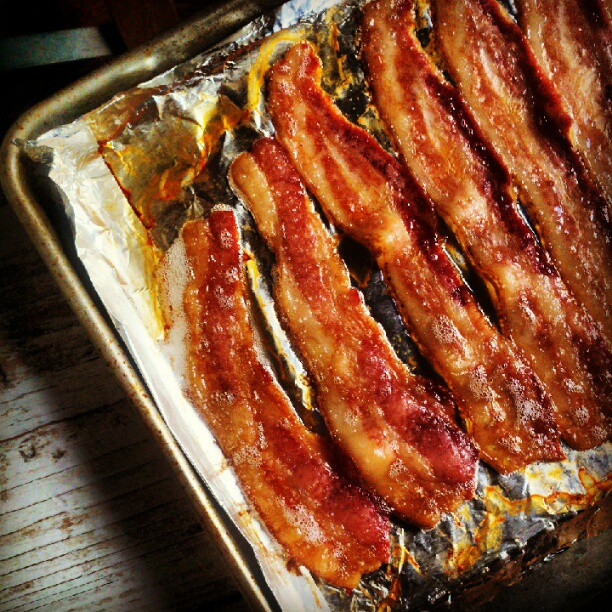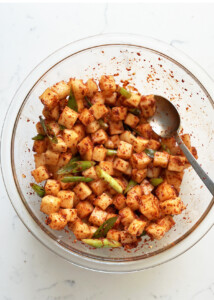How to cook bacon into perfect waves first, resources and my personal notes after.
HOW TO COOK BACON INTO WAVY STRIPS
This method of cooking bacon uses the oven. If you don't have a rack, follow the instructions in the Notes and Resources section after the recipe to build a make-shift "rack" out of aluminum foil.
Ingredients
one 10-, 12-, or 16-ounce package of bacon
Tools and Equipment
large rimmed baking sheet
aluminum foil
baking rack that fits on baking sheet
Directions
Move oven racks to make sure there is enough space for the baking sheet with the baking rack on it.
Heat oven to 400°F.
Shape the Bacon on the Baking Rack: Line the baking sheet with aluminum foil, going up and over the sides. The aluminum foil will catch the bacon grease as it renders out and drips into the pan, making clean-up easier.
Place a strip of bacon with one end on the far edge of the rack. Fold the end over the bar and let it hang down by about 1-inch. Carefully push small sections of the rest of the bacon strip down between the bars of the rack, letting the sections hang down about ¾-inch. The bacon shrinks as it cooks and will lift itself up slightly from between the bars. Depending on how many waves you shape into the bacon strip, let the end piece hang down through the bars as long as it's not too long, or pinch the end around a bar. See photo below for guidance.
Repeat the same process with all of the bacon strips. It is okay if the bacon strips touch each other, but do not let them overlap.
Roast the Bacon: Carefully transfer the entire baking sheet and rack to the oven. Roast the bacon until your preferred doneness. Start checking the bacon after approximately 15 minutes. When the bacon is done, remove baking sheet from oven to cool. The bacon continues to cook for a minute or two after you remove it from the oven, so if you like, soft, chewy bacon, remove the baking sheet a little earlier than you would expect.
The bacon needs to cool into its shape. If you try to remove the bacon from the rack too soon, it may not retain its wavy shape. Once the bacon is cool to the touch, carefully lift each strip off the rack. There is no need to "drain" the bacon, as a lot of fat has dripped right off onto the foil in the baking sheet.
NOTES and RESOURCES
- Bacon: This method works best with regular thickness bacon. Thick slices are harder to shape onto the rack, and tend not to hold the wavy shape as well as thinner slices.
- Lining the Baking Sheet: You can use parchment paper to line the baking sheet to catch the bacon grease, but it's a little harder to keep parchment paper in place up the sides of the baking sheet.
- If You Don't Have a Rack: Create a "rack" using pieces of aluminum foil. Line a baking sheet exactly as outlined above. Tear off about 6 sheets of aluminum foil about 10 inches wide. Crumple each aluminum sheet into a long bars, about 2 inches tall when you lay them down. Line up the aluminum "bars" on the baking sheet about 1 inch apart. Shape the bacon strips over the aluminum "bars." There won't be as much space between the baconand the drippings in the baking sheet, but that's ok. This is actually the easiest to clean-up since you don'teven have to wash a rack.











Leave a Reply